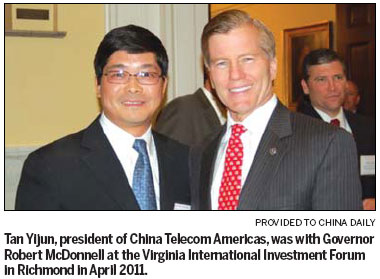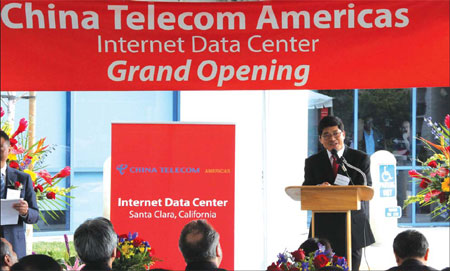China Telecom busy exploring, cultivating Americas market
Updated: 2012-05-25 12:04
By Tan Yingzi in Washington (China Daily)
|
||||||||
|
China Telecom Americas opened its first Internet Data Center in the US in Santa Clara, California, on May 20, 2011. The center has a direct network connection to China and serves multinational enterprises for their co-location, managed services and cloud computing services. Provided to China Daily |

Tan Yijun looks like a scholar but is really an explorer with ambition. After 10 years of cultivating business for China Telecom Corp's Western Hemisphere subsidiary, he views the region as a whole.
"We're now paying great attention to developing in new regions, opening new operations and trying new businesses models," the president of China Telecom Americas told China Daily.
CT Americas, the biggest overseas arm of China Telecom, will further expand in Central America and South America, forging strategic partnerships with local telecom operators and providing international service to users, Tan said.
China Telecom is the fastest-growing mobile provider in China. Users of its network (on the code-division multiple access, or CDMA, standard) topped 130 million in December 2011, making it the world's biggest CDMA operator.
Set up in 2002, CT Americas has focused on serving multinational companies with leased-line, Internet, managed and wholesale (enterprise) voice services as well as data centers.
Relying on its resources in China, the company's major clients are Chinese enterprises doing business in the US such as Bank of China Ltd and China Petroleum & Chemical Corp (Sinopec) as well as US companies invested in China such as Microsoft Corp and Bank of America Corp.
The company is based in the Washington, DC, suburb of Herndon, Virginia, and has seven branches - Los Angeles and San Jose in California; Chicago; New York; Canada; Brazil; and Venezuela. Offices in Argentina and Mexico are set to open soon.
"Our overseas expansion will try to reach out to those non-China markets, such as the telecommunication solutions between North America and South America, based not on our resources in China but our overseas infrastructure," Tan said.
In booming tourism and business exchanges between China and the US in recent years, CT Americas saw huge potential for its mobile and data services. It began developing its US retail presence this year.
"This is the market we must work on," Tan said.
CT Americas began rolling out its branded mobile service in Chicago in January; plans are for similar rollouts in Los Angeles and New York, the major destinations for Chinese visitors and home to the greatest number of Chinese- Americans. Subscriber phones using the service will carry a China Telecom logo and one SIM card with two numbers - one China-based and one US-based mobile, with the subscriber reachable on both.
The new service is aimed at frequent business travelers, long-term visitors and students. The international calling rate will be lower than that offered by domestic US telecoms but slightly higher than a calling card, Tan said.
"But the mobile service is just a new experiment for us," he added. "We will still focus greatly on our existing products
and services, which is the major source of the revenue in coming years."
To address the rapid growth of the Chinese Internet and increased demand from multinational enterprises, China Telecom decided to expand its overseas business.
In 2000 the giant set foot in Los Angeles. Two years later, it formally launched its US operations with the opening of its
headquarters in Herndon, part of a regional tech corridor that also hosts Verizon Communications, AOL, Sprint, NTT America, HKT Group Holdings' PCCW Global and Singapore Telecommunications Ltd (SingTel).
"We tried to avoid the places favored by most Chinese companies," Tan said. "CT Americas should become a true American company and grow in a real American business environment."
So far, over 80 percent of its employees in the US are locally hired and most revenue comes from service to multinational
companies, the executive said.
CT Americas is also an active corporate citizen. It engages with the local and federal governments, helping organize business-promotion tours to China. It also lobbies legislators and policy-makers on concerns among Chinese investors in the
US such as visa and labor regulations.
The company has grown rapidly on US soil. Between 2004 and 2010, its average annual growth rate was 40 percent. The global financial crisis was partly responsible for the pace slowing to 20 percent in 2010 and 2011.
It's now the largest Chinese investor in Virginia with more than $50 million committed. To improve its local telecommunications infrastructure, the total investment will reach about $100 million in the near future, Tan said.
Tan has spent more than 20 years in telecommunications, including the last six with CT Americas. Before that, he oversaw
the network providing data communication services throughout China's Hunan province.
He earned a bachelor's degree from Shanghai Jiao Tong University, where he majored in electronics and telecommunications.
He earned a master's degree from Huazhong Technology University and his MBA at Hunan Province Commercial Institute.
Though the telecom business environment in the US is "open, fair, orderly and regulated," Tan said, he describes competition
in the market as "white-hot" and "fierce".
Facing so many big local players and demanding clients, "the key to success in the US is to meet the demand of the customers," he said. And the demand can be surprisingly straightforward for a Chinese business operator, who would have to manage guanxi or relationship on a consistent basis in China.
Tan recalled that soon after taking the helm of CT Americas in 2006, he visited clients on the West Coast. To his surprise,
one client sent an engineer to meet him, instead of anyone from management.
"It turned out to be very good," Tan said. The engineer was in charge of the department that CT Americas was working with and understood its services.
"He was very straightforward and pointed out our problems, so we could solve them quickly and improve our services."
The other thing he has learned about is cooperation with competitors.
CT Americas submitted a bid in Chicago for a services contract from a Fortune 500 food company but failed. Impressed by Tan's presentation, the bid winner later tracked down the executive and said he wanted to work with the company on the bid project.
"This is very hard to imagine in China," Tan said. "But in the US, there is always opportunity out there. Never give up."
tanyingzi@chinadailyusa.com

 Relief reaches isolated village
Relief reaches isolated village
 Rainfall poses new threats to quake-hit region
Rainfall poses new threats to quake-hit region
 Funerals begin for Boston bombing victims
Funerals begin for Boston bombing victims
 Quake takeaway from China's Air Force
Quake takeaway from China's Air Force
 Obama celebrates young inventors at science fair
Obama celebrates young inventors at science fair
 Earth Day marked around the world
Earth Day marked around the world
 Volunteer team helping students find sense of normalcy
Volunteer team helping students find sense of normalcy
 Ethnic groups quick to join rescue efforts
Ethnic groups quick to join rescue efforts
Most Viewed
Editor's Picks

|

|

|

|

|

|
Today's Top News
Health new priority for quake zone
Xi meets US top military officer
Japan's boats driven out of Diaoyu
China mulls online shopping legislation
Bird flu death toll rises to 22
Putin appoints new ambassador to China
Japanese ships blocked from Diaoyu Islands
Inspired by Guan, more Chinese pick up golf
US Weekly

|

|







